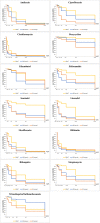Drug susceptibility testing of slowly growing non-tuberculous mycobacteria using slomyco test-system
- PMID: 30222736
- PMCID: PMC6141080
- DOI: 10.1371/journal.pone.0203108
Drug susceptibility testing of slowly growing non-tuberculous mycobacteria using slomyco test-system
Abstract
Objective: The objective of the research was to assess the susceptibility of the slowly growing nontuberculous mycobacteria strains to the antimicrobial drugs used for mycobaterioses treatment using SLOMYCO test system.
Materials and methods: We assessed 363 NTM strains: 177 MAC (161 M. avium, 16 M. intracellulare), 112 M. kansasii and 74 M. xenopi collected from the respiratory material of the patients were under the treatment or under diagnostic procedures at our Center, affiliates and the diagnostic department in 2010-2016. Drug sucseptibility for NTM was tested using the Sensititre SLOWMYCO system (TREK DIAGNOSTIC Systems Ltd., UK). MICs were established by microdilutions in Mueller-Hinton broth on polystyrene 96-well plates. The statistical analysis was done using the StatGraphics Plus 5.0 software. The data were compared pairwise using Pearson χ2 test with Yates correction. 95% confidence interval (CI) were calculated. Statistically significant differences were considered for p <0.05. Log-rank test and Kaplan-Meier curves were used to assess the concentration-dependent surveillance probability.
Results: The statistically significant differences were revealed in sensitivity/resistance isolates of M. avium and M. intracellulare: M. avium strains were resistant to higher concentrations of amikacin, clarithromycin, linezolid and streptomycin (p <0.01); M. intracellulare strains were resistant to higher concentrations of ethionamide (p <0.05). The isolates of M. avium were significantly more resistant than M. kansasii to amikacin, doxycycline, isoniazid, clarithromycin, linezolid, moxifloxacin, rifabutin, rifampicin, streptomycin, trimethoprim/sulfamethoxazole, ciprofloxacin, ethambutol, ethionamide (visible growth of M. avium were inhibited by higher drug concentrations, p <0.01). The isolates of M. avium showed significantly higher resistance than M. xenopi to amikacin, doxycycline, isoniazid, clarithromycin, linezolid, moxifloxacin, rifampicin, streptomycin, trimethoprim/sulfamethoxazole, ciprofloxacin, ethambutol, and ethionamide (visible growth of M. avium were inhibited by higher drug concentrations, p <0.01). Statistically significant differences in the dynamics of the response to the antibacterial effects of isoniazid, linezolid, moxifloxacin, rifampicin, trimethoprim/sulfamethoxazole, ethambutol, and ethionamide were found for M. intracellulare and M. xenopi (complete inhibition of the visible growth of M. intracellulare required higher drugs concentrations, p <0, 05). Comparison of the Kaplan-Meyer curves revealed statistically significant differences in survialence probability of M. kansasii and M. xenopi for amikacin, doxycycline, rifampicin, trimethoprim/sulfamethoxazole, ciprofloxacin, ethambutol, and ethionamide (a higher number of isolates of M. xenopi were inhibited by low drugs concentrations, p <0.05).
Conclusions: Our data show that M. avium and M. intracellulare were more resistant to the majority of the studied drugs than M. kansasii and M. xenopi.
Conflict of interest statement
The authors have declared that no competing interests exist.
Figures
Similar articles
-
Antimicrobial susceptibility and minimum inhibitory concentration distribution of common clinically relevant non-tuberculous mycobacterial isolates from the respiratory tract.Ann Med. 2022 Dec;54(1):2500-2510. doi: 10.1080/07853890.2022.2121984. Ann Med. 2022. PMID: 36120867 Free PMC article.
-
In Vitro Antimicrobial Susceptibility of Nontuberculous Mycobacteria in Iran.Microb Drug Resist. 2016 Mar;22(2):172-8. doi: 10.1089/mdr.2015.0134. Epub 2015 Oct 15. Microb Drug Resist. 2016. PMID: 26468990
-
[Frequently Isolated Slow Growing Nontuberculous Mycobacteria from Pulmonary Samples and Evaluation of Drug Susceptibility Testing Results in a Referral Hospital in Turkey].Mikrobiyol Bul. 2019 Jul;53(3):330-335. doi: 10.5578/mb.68091. Mikrobiyol Bul. 2019. PMID: 31414634 Turkish.
-
Treatment of Other Nontuberculous Mycobacteria.Semin Respir Crit Care Med. 2018 Jun;39(3):377-382. doi: 10.1055/s-0038-1660473. Epub 2018 Aug 2. Semin Respir Crit Care Med. 2018. PMID: 30071552 Review.
-
Drug susceptibility testing of nontuberculous mycobacteria.Future Microbiol. 2014;9(9):1095-110. doi: 10.2217/fmb.14.60. Future Microbiol. 2014. PMID: 25340838 Review.
Cited by
-
Rational Choice of Antibiotics and Media for Mycobacterium avium Complex Drug Susceptibility Testing.Front Microbiol. 2020 Feb 19;11:81. doi: 10.3389/fmicb.2020.00081. eCollection 2020. Front Microbiol. 2020. PMID: 32140138 Free PMC article.
-
Factors Associated with Treatment Outcome in Patients with Nontuberculous Mycobacterial Pulmonary Disease: A Large Population-Based Retrospective Cohort Study in Shanghai.Trop Med Infect Dis. 2022 Feb 15;7(2):27. doi: 10.3390/tropicalmed7020027. Trop Med Infect Dis. 2022. PMID: 35202222 Free PMC article.
-
Rifampin Pharmacokinetics/Pharmacodynamics in the Hollow-Fiber Model of Mycobacterium kansasii Infection.Antimicrob Agents Chemother. 2022 Apr 19;66(4):e0232021. doi: 10.1128/aac.02320-21. Epub 2022 Mar 22. Antimicrob Agents Chemother. 2022. PMID: 35315686 Free PMC article.
-
Phenotypic drug-susceptibility profiles and genetic analysis based on whole-genome sequencing of Mycobacterium avium complex isolates in Thailand.PLoS One. 2023 Nov 22;18(11):e0294677. doi: 10.1371/journal.pone.0294677. eCollection 2023. PLoS One. 2023. PMID: 37992075 Free PMC article.
-
Mutation patterns of resistance genes for macrolides, aminoglycosides, and rifampicin in non-tuberculous mycobacteria isolates from Kenya.F1000Res. 2023 Apr 3;11:962. doi: 10.12688/f1000research.124002.5. eCollection 2022. F1000Res. 2023. PMID: 37224326 Free PMC article.
References
-
- Adle-Biassette H., Huerre M., Breton G., Ruimy R., Carbonnelle A., Trophilme D., et al. Nontuberculous mycobacterial diseases. Ann. Pathol. 2003; 23(3):216–235. - PubMed
-
- Otten T.F., Vasiliev A.V. Mycobacteriosis St. Petersburg: Med. Press;2005.
-
- Brown-Elliott B., Wallace R. Infections caused by nontuberculous mycobacteria. In: Principles and Practice of Infectious Disease. (eds. Mandell G.). 2005; 2: 2909–2916.
MeSH terms
Substances
LinkOut - more resources
Full Text Sources
Other Literature Sources
Medical


